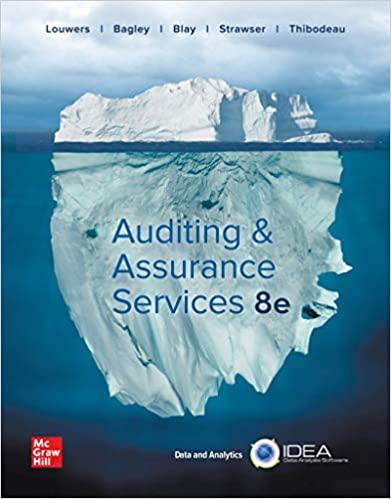Answered step by step
Verified Expert Solution
Question
1 Approved Answer
Marin Inc. owns 25% of the common shares of Riverbed Corp. The other 75% of the shares are owned by the Riverbed family. Marin acquired
Marin Inc. owns 25% of the common shares of Riverbed Corp. The other 75% of the shares are owned by the Riverbed family. Marin acquired the shares eight years ago through a financing transaction. Each year, Marin has received a dividend from Riverbed. Riverbed has been in business for 60 years and continues to have strong operations and cash flows. Marin must determine the fair value of this investment at its year-end. Since there is no market on which the shares are traded, Marin must use a discounted cash flow model to determine fair value. Marin management intends to hold the shares for 5 more years, at which time they will sell the shares to the Riverbed family under an existing agreement for $1 million. There is no uncertainty in this amount. Management expects to receive dividends of $80,500 for each of the five years, although there is a 20% chance that dividends could be $48,000 each year. The risk-free rate is 3% and the risk-adjusted rate is 5% There is many parts to this question A) Calculate the fair Value of the investment in Riverbed using the traditional approach with the Present Value Table the Answer: You have two calculations to perform. Under the traditional approach: The first is the present value of the 1 million which is a one-time payment. As it is a one-time payment you would use the present value of 1 table to calculate the present value. The second is the present value of $80,500 annual dividends received over five years. As this is multiple payments you would use the present value of an annuity table to calculate the present value. Annual cash expected = $80,500 PV factor of annuity, 5 years, 5% = $80,500 4.32948 = $348,523 Plus, the sale proceeds expected at the end of year 5 = $1,000,000 PV factor of lump sum, 5 years, 5% = $1,000,000 0.78353 = 783,530 The fair value is the sum of the two amounts: = $348,523 + $783,530 = $1,132,053 The expected cash flow approach uses the same present value tables but you need to calculate the weighted average of the expected dividend payments. The probability-weighted annual cash flow is: $80,500 80% = $64,400 $48,000 20% = 9,600 $74,000 PART B: Calculate the fair value of the investment using the expected Cash flow approach ( this is the calculation i require) PV table is provided n period 2% 2.5% 3% 4% 5% 6% 8% 9% 10% 11% 12% 15% 1 0.98039 0.97561 0.97087 0.96156 0.95238 0.94340 0.92593 0.91743 0.90909 0.90090 0.89286 0.86957 2 0.96117 0.95181 0.94260 0.92456 0.90703 0.89000 0.85734 0.84168 0.82645 0.81162 0.79719 0.75614 3 0.94232 0.92860 0.91514 0.88900 0.86384 0.83962 0.79383 0.77218 0.75132 0.73119 0.71178 0.65752 4 0.92385 0.90595 0.88849 0.85480 0.82270 0.79209 0.73503 0.70843 0.68301 0.65873 0.63552 0.57175 5 0.90583 0.88385 0.86261 0.82193 0.78353 0.74726 0.68058 0.64993 0.62092 0.59345 0.56743 0.49718 6 0.88797 0.86230 0.83748 0.79031 0.74622 0.70496 0.63017 0.59627 0.56447 0.53464 0.50663 0.43233 7 0.87056 0.84127 0.81309 0.75992 0.71068 0.66506 0.58349 0.54703 0.51316 0.48166 0.45235 0.37594 8 0.85349 0.82075 0.78941 0.73069 0.67684 0.62741 0.54027 0.50187 0.46651 0.43393 0.40388 0.32690 9 0.83676 0.80073 0.76642 0.70259 0.64461 0.59190 0.50025 0.46043 0.42410 0.39092 0.36061 0.28426 10 0.82035 0.78120 0.74409 0.67556 0.61391 0.55839 0.46319 0.42241 0.38554 0.35218 0.32197 0.24719 11 0.80426 0.76214 0.72242 0.64958 0.58468 0.52679 0.42888 0.38753 0.35049 0.31728 0.28748 0.21494 12 0.78849 0.74356 0.70138 0.62460 0.55684 0.49697 0.39711 0.35554 0.31863 0.28584 0.25668 0.18691
Step by Step Solution
There are 3 Steps involved in it
Step: 1

Get Instant Access to Expert-Tailored Solutions
See step-by-step solutions with expert insights and AI powered tools for academic success
Step: 2

Step: 3

Ace Your Homework with AI
Get the answers you need in no time with our AI-driven, step-by-step assistance
Get Started


